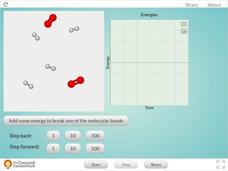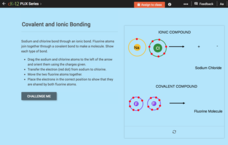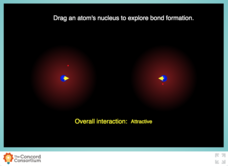Curated OER
Sometimes, solid + liquid = gas
Third graders experiment with common household liquids and solids. In this chemical reaction lesson, 3rd graders discuss phase changes and experiment to find other ways to create gases. They use water, vinegar, lemon juice, flour, baking...
Curated OER
Energy and Energy Conversion
Third graders investigate different energy conversions through hands-on activities. In this energy lesson, 3rd graders move through four stations and conduct experiments illustrating energy conversions. Wave energy, chemical energy,...
Curated OER
Enthalpy of Reaction and Hess' Law
In this chemical reactions worksheet, students use a standard enthalpy table to find the enthalpy of reaction for list of different fuels. This worksheet has 4 problems to solve.
Curated OER
Equilibrium Practice
In this chemical reactions worksheet, students determine solubility product expressions, equilibrium constants, and equilibrium concentrations. This worksheet has 15 multiple choice questions and 3 problems to solve.
Curated OER
Food Matters
Fifth graders identify physical and chemical changes. In this science inquiry lesson, 5th graders observe the changes that occur when making bread and butter. Students explain if the product is result of a physical or chemical change.
Curated OER
Invisible Ink
Pupils are introduced to the concept of chemical change when they observe the chemical change that occurs between vinegar or lemon juice and heat.
Curated OER
Activity #20 Tear An Aluminum Can In Half
Students observe the chemical reaction between CuCl2 and aluminum. They identify the evidence for a chemical change. Pupils answer the following questions after observing the experiment: How do you know a chemical reaction occurred?,...
Curated OER
Breaking it Down
High schoolers will identify the factors that contribute to erosion and weathering. They will start by differentiating between chemical and mechanical weathering. They then apply what they learned by playing the online jeopardy game. Key...
Curated OER
Laboratory: Observing a Candle
In this observation worksheet, scientists observe a burning candle and answer eight post-lab questions. Topics include the phase changes occurring during the observations, the role each part of the candle plays in the chemical reaction,...
American Chemical Society
Comparing the Amount of Acid in Different Solutions
Upcoming chemists use chemical reactions to determine relative pH in two different acids. This is a terrific lesson plan for middle schoolers that can stand alone as a practice in precision and lab skills, or as part of the unit on...
Concord Consortium
Reaction Between Hydrogen and Oxygen Molecules
When molecules of hydrogen and oxygen are combined, how does water form? Science scholars observe changes in kinetic and potential energy during a chemical reaction in an interactive. The resource features easy controls that allow users...
Curated OER
Science: The States of Matter
Third graders conduct experiments in matter to create chemical changes resulting in gases. By mixing solids and liquids, they create a chemical reaction and capture the gas in balloons. After observing the balloons fill with carbon...
Chymist
An Experiment in Alchemy: Copper to Silver to Gold
Use chemistry to change pennies into gold coins! The experimental procedure leads learners through the process of changing copper pennies to silver and then to gold. They record the mass of each coin through every step of the experiment.
American Chemical Society
Neutralizing Acids and Bases
Now that your science class has experimented with pH indicator and identified acids and bases, they attempt to get the cabbage juice indicator back to its original color. This is done through neutralization of the acids and bases that...
Concord Consortium
Breaking a Molecular Bond
Breaking up is hard, especially with a third part involved! Watch as molecules of hydrogen, oxygen, and nitrogen try to keep it together as a neutral third atom bombards them. Users control the reactive molecules and the velocity of the...
Beyond Benign
Exothermic and Endothermic Reactions
How can you tell the difference between endothermic and exothermic reactions? Chemistry scholars perform and observe two chemical reactions, measure the temperature throughout, then draw conclusions about changes in energy from their...
CK-12 Foundation
Chemical Bonds: Covalent and Ionic Bonding
Get back to bonding basics. Science scholars get a chance to show what they know using a simple interactive. Pupils create models of covalent and ionic bonds before answering questions about each interaction. The resource includes a...
NOAA
Energy from the Oceans
Can Earth's oceans produce a steady supply of clean energy? Scholars explore the uses of tidal and thermal energy in the 11th installment of a 13-part series about ocean-based alternative energy sources. Learners examine the current...
Concord Consortium
Forming a Molecular Bond
They say two's company, but three's a crowd... unless you're talking about molecular bonding! Chemistry scholars experiment with two- versus three-atom bonding in an engaging simulation. Learners must place the third atom in a location...
Concord Consortium
Forming a Molecule
What does it look like when two atoms bond? Mol-e-COOL! Aspiring chemists observe the interaction between two atoms forming a bond in an easy-to-use interactive. Individuals move atoms closer together and observe changes in attraction...
Royal Society of Chemistry
A Reversible Reaction of Hydrated Copper (II) Sulfate
How can removing water change the color of a substance? Lab partners remove the water of crystallization from hydrated copper (II) sulfate, record their observations, then rehydrate the solid. The resource is printable and contains ideas...
Curated OER
Physical and Chemical Changes in Food
Ninth graders study food mixtures and substances in order to identify atoms, molecules, elements, and compounds and recognize physical changes that take place in foods.
Curated OER
Striking it Rich with Chemistry
Young scholars identify the composition of different pennies. In this chemistry lesson plan, students use a post 1982 penny to observe chemical change. They explain how to turn a penny from copper to gold.
Curated OER
Things Are Heating Up
In this science instructional activity, students read about chemical changes. Students also answer 3 comprehension questions about the reading.
Other popular searches
- Physical and Chemical Changes
- Chemical Changes in Matter
- Physical Chemical Changes
- Chemical Changes in Rocks
- Chemical Changes Rust
- Matter Chemical Changes
- Chemical Changes Indicators
- What Are Chemical Changes
- Rates of Chemical Changes
- Chemical Changes Rusting
- Chemical Changes of Matter
- Physical/chemical Changes

























